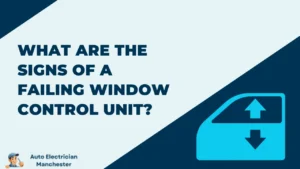
Car windows stuck open or closed can be a real inconvenience, especially during unpredictable weather. But don’t fret! Before you head straight to a mechanic, some simple troubleshooting steps can help you identify the culprit and potentially fix the issue yourself. This guide empowers you to diagnose your car’s window control unit (WCU) at home, saving you time and money.
Is it the WCU or Something Else?
Before diving into the WCU, let’s narrow down the possibilities. Here’s how to isolate the problem:
One Window Woes vs. Multi-Window Mayhem: Check if all your windows are affected. If just one window is misbehaving, the issue likely lies with that specific window’s switch or motor, not the WCU, which controls all windows.
The Power of Listening: When you press the window switch, pay attention for any clicking sounds. A faint click might indicate a failing switch, while a complete absence of sound suggests a wiring or WCU problem.
Master Switch Mischief: Some cars have a master window lock switch on the driver’s door. Ensure it’s not accidentally engaged, as this can prevent all window operation.
Easy Fixes: Solutions You Can Try Yourself
Once you’ve isolated the problem to the WCU, here are some easy fixes you can attempt:
Fuse Box Frenzy: Consult your car’s owner’s manual to locate the window control unit fuse. A blown fuse can disable all windows. Look for a small diagram in the manual that corresponds to your car’s fuse box layout. Identify the window control unit fuse and replace it with one of the same amperage rating (usually printed on the fuse itself).
The Power of a Reset: Sometimes, a simple glitch can cause the WCU to malfunction. Try disconnecting the car battery for a few minutes, then reconnecting. This can reset the system and potentially resolve the issue.
Remember: These steps are for basic troubleshooting. If the problem persists after trying these easy fixes, it might be time to consider more advanced solutions.
Advanced Troubleshooting and Safety
While the methods above can address common WCU issues, there are situations where seeking professional help is recommended:
Advanced Electrical Diagnosis: Car window control units are connected to a complex web of wires and electrical components. If the basic troubleshooting steps don’t work, you might need specialized electrical diagnostic tools to pinpoint the exact cause of the problem. A mechanic will have the necessary equipment and expertise to accurately diagnose the issue.
Delicate Do Not Touch: The WCU itself is a delicate electronic component. Avoid fiddling with it or attempting repairs yourself, as this can cause further damage. Leave intricate repairs to a qualified mechanic.
Safety First: Remember, safety is paramount when dealing with car electrical systems. If you’re not comfortable with any of the troubleshooting steps, don’t hesitate to seek professional help. A mechanic can ensure your safety while diagnosing and repairing the window control unit.
Advanced Troubleshooting Techniques
The troubleshooting steps mentioned earlier can address common window control unit (WCU) woes. But what if those simple fixes don’t solve the problem? If you’re comfortable venturing a bit deeper (and possess some basic mechanical knowledge), here are some advanced troubleshooting techniques you can try:
Visual Inspection: Once you’ve narrowed down the problem to the WCU, you can visually inspect the unit for any signs of damage. Look for burn marks, corrosion, or loose connections on the WCU itself or the wiring harness that connects to it. While this might not pinpoint the exact cause, it can provide clues about potential electrical faults.
Multimeter Magic: If you have a multimeter, you can attempt some basic electrical tests on the WCU. However, this process requires a good understanding of electrical circuits and the WCU’s wiring schematics (which can usually be found in your car’s repair manual). By measuring voltage and continuity at specific points on the WCU, you can potentially identify malfunctions within the unit.
Cleaning the Connections: Corrosion on the electrical connections between the WCU and the wiring harness can sometimes disrupt proper functioning. If you spot any corrosion, you can carefully clean the connections with a non-abrasive electrical contact cleaner.
Caution: Always disconnect the car battery before attempting any cleaning procedures on electrical components.
Understanding Warning Signs
While the DIY troubleshooting techniques mentioned above can be tempting, there are instances where seeking professional help from a mechanic is the wisest course of action:
Complex Issues: If your troubleshooting efforts don’t yield any results, or the problem seems more intricate, it’s best to leave it to the professionals. Mechanics have the expertise and advanced diagnostic tools to pinpoint complex electrical faults within the WCU or related car systems.
Smoke Signals: If you see smoke coming from the WCU or smell burning wires, immediately disconnect the car battery and avoid further tampering. This is a clear sign of a major electrical malfunction that requires professional attention.
Air Bag Integration: Some modern cars have window control units integrated with the air bag deployment system. If your car falls into this category, it’s crucial to leave any troubleshooting or repairs to a certified mechanic to avoid accidental air bag deployment.
Preventive Maintenance Tips
By following these preventive maintenance tips, you can help ensure the longevity of your car’s window control unit and avoid future problems:
Avoid Excessive Window Use: While convenient, constantly rolling the windows up and down, especially in extreme weather conditions, can put extra strain on the WCU and window motors. Try to limit unnecessary window operation, especially during very hot or cold weather.
Keep it Clean: Spills or debris inside the car door can sometimes migrate and cause corrosion on the WCU’s electrical connections. Regularly clean your car doors, including the areas around the window switches and controls, to prevent such issues.
Listen to the Sounds: Pay attention to any unusual noises coming from the windows while operating them. Grinding noises or excessive strain could indicate failing window regulators, which can put extra stress on the WCU. Addressing these issues promptly can help prevent WCU problems down the line.
Conclusion
By following this guide and understanding the information above, you’re well on your way to diagnosing your car’s window control unit like a pro. Remember, if the problem persists after the initial troubleshooting, don’t hesitate to seek professional help from a qualified mechanic. They can ensure a safe and efficient repair, getting your car windows rolling smoothly once again.
FAQ
How much does it cost to replace a window control unit?
The cost can vary depending on your car make and model. However, it typically ranges from $100 to $300 for the part and labor.

David Mack is a seasoned writer with a passion for the auto electrician niche. With years of hands-on experience and a knack for demystifying complex topics, David brings practical insights to his readers. Whether you’re a professional or a car enthusiast, his engaging articles offer valuable tips and trends in auto electrical systems.
